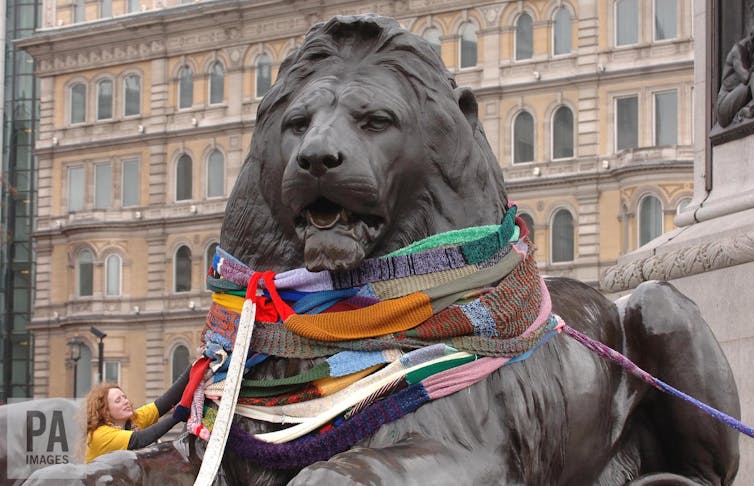The day after Donald Trump’s inauguration on January 21, millions rallied together across the world in a series of Women’s Marches intended to demonstrate solidarity with other women, and promote issues of gender equality in the face of the new Trump administration’s regressive politics.
Among the many images that resonated from the marches were the pussyhats which became the protest’s informal symbol. Simply knitted, brightly coloured, and reclaiming the language of one of Trump’s more heinous campaign controversies, pussyhats were handcrafted by participants to “create a collective visual statement and help activists be better heard”. This statement was arguably so effective that one week on from the protests, Time Magazine has chosen to feature the pussyhat on its front cover.
On seeing these crafty symbols of resistance, one of Trump’s aides questioned whether the hats were made in America or foreign imports, belying a scepticism both of the protesters’ authenticity, and of the very notion of the handcrafted.
But as Abbysyarns on Buzzfeed Community noted, and as anyone who crafts themselves will tell you, it is obvious from their imperfections that these lumpy and hastily-knitted hats were (hand)made locally in America – and in the other countries where protests took place. As the online comments using the community #pussyhat hashtag highlight, they were knitted and crocheted by hands furious for an outlet, and eager for a tangible way to channel their anger at the divisive politics Trump and his supporters embody.
In fact, it is not surprising that a handcrafted object would become central to a protest movement like the Women’s March. Craft has long been used to make political statements. Rozsika Parker, for example, has written about how second-wave feminist artists in the 1970s chose embroidery as the “perfect medium to give form to consciousness-raising”, and the last decade saw knitting resurge in popularity, as it was reclaimed from its grandmotherly image and transformed into a subversive craft regularly deployed for political purposes.
Stitch ‘n’ Bitch
Third-wave feminist and Bust Magazine editor Debbie Stoller led this subversive knitting trend, with the publication of her Stitch ‘n’ Bitch knitting manual, calling for a new generation of knitters to “take back the knit”.

There has been considerable scholarly attention to this type of contemporary knitting with feminist authors exploring knitting’s “craftivism” through practices like yarn bombing, knitting prosthetic breasts for mastectomy patients, and knitathons. These activities can build crafting communities which can function as sites of resistance to injustice and inequality. It is here that the PussyHat Project arguably connects.
Craft is also a slow process, and in submitting to this temporality and engaging in intentional processes of making as in the PussyHat Project, we give ourselves space to consider our position on big social or political questions, and to consider how we might each contribute to creating more resilient communities. Crafts like knitting offer the opportunity to engage with questions of global political significance in a tangible way. As Betsy Greer who coined the term “craftivism” said, “the creation of things by hand leads to a better understanding of democracy, because it reminds us that we have power”.
Radical action
It’s also important to note how powerful and transformative its effects can be at the individual level. There’s a growing body of research which highlights the ways in which craft can be a powerful tool for individual mental and physical health. The WellMaking project at Falmouth University, for example, focused on the ways that craft can help people connect and reflect in therapeutic ways. A recent study by the Women’s Institute in the UK found that craft has a positive benefit on mental health. And my own research into what I call the “digital dressmaking community” has found that for many “digital dressmakers”, sewing offers an important space for being kind to ourselves and practising self-care.
But craftivism also enables us to reflect on broader questions about the very place and power of craft itself. Fiona Hackney’s work, for example, and my own research on the revival of home dressmaking, have both explored the ways in which acts of craftivism may allow for a feminist reclaiming of traditionally feminine skills. This exemplifies craftivism’s power: it offers the space to advocate for social change in a gentle way, while presenting a radical opportunity to question the meanings we associate with certain practices.
A common criticism of these revived craft practices is that they distract from supposedly “real” political issues, and that they are simply a form of “cupcake feminism”. This is arguably why the sight of pussyhats in the Women’s March was so powerful: that traditionally “feminine” crafts, which have been viewed as antithetical to radical/feminist action, are being deployed precisely for such aims. In these times of dark political shifts and considerable global anxiety, that the Women’s March participants would choose to turn to craft to send a message to Trump and his allies seems to be entirely appropriate.

